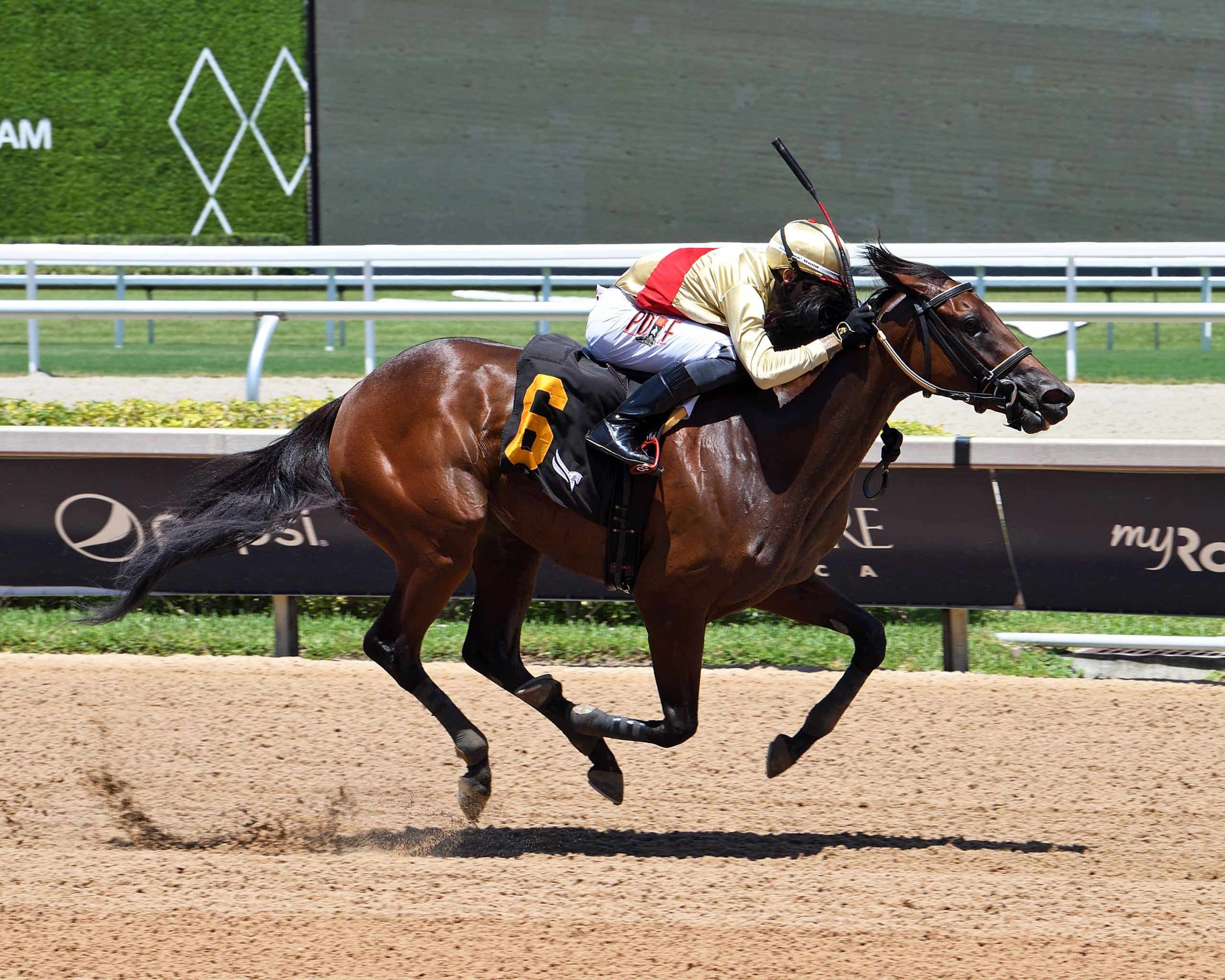
Bee a Queen breaks her maiden at Gulfstream Park. Photos by Ryan Thompson
Every race day has a story—and for Thoroughbred racehorses, it begins long before the starting gates fly open. From pre-dawn feedings to post-race recovery, trainers and caretakers carefully orchestrate a racehorse’s day around his health, comfort and performance. In this article we follow Bee A Queen, offering a behind-the-scenes look at the care, preparation and horsemanship that go into race day for many Thoroughbreds.
Bee A Queen
Bee A Queen, known as Queenie around the barn, is a 3-year-old bay filly by Khozan out of Queen Brunette, by Uncle Mo. Jena Antonucci, a trainer based in Ocala, Florida, also owns Queenie.
“She breaks the mold when it comes to the typical mare stereotype,” says Antonucci. “There’s also this perception that Thoroughbred racehorses are hot, high-strung and bouncing off the walls—but Queenie’s the opposite. She’s composed, smart and has a good head on her shoulders. She’s actually more of the snuggly, affectionate type—more loving than what you’d expect from the usual mare reputation.”
Antonucci made history as the first woman to train an American Triple Crown race winner when Arcangelo won the Belmont Stakes (Gr. 1) in 2023. She also became only the second female trainer to win the Travers Stakes (Gr. 1), also with Arcangelo. She also co-owns HorseOlogy, a minority- and women-owned Thoroughbred training and ownership group that includes Encore, a nonprofit for rehoming and retraining off-track Thoroughbreds in Ocala.
“We had purchased Bee A Queen at auction as a Florida-bred with the goal of competing in the Florida series, and we did just that,” Antonucci says. “But afterwards, she just needed a minute. Her last race was in February of this year, and we decided to take her back to the farm. We gave her the time she needed to grow up, mature a bit and really come into herself.”
Like Queenie, many racehorses get ample downtime between races to rest and recover—despite the common myth they’re always in training. Giving Queenie the time she needed to mature truly paid off. She returned to the races on June 14, 2025, put it all together and delivered an impressive victory.
“It was almost a four-month layup, which was great for her—I think it’s exactly what she needed,” says Antonucci. “Often, they benefit from 60 to 90 days of downtime and, in Queenie’s case, she had about 60 days without any speed work. She wasn’t completely out of training for long, but we pulled back on the speed work to just let her relax, graze and mentally reset. She started breezing again in late April. From there, we brought her back gradually, spacing out her breezes every seven to 10 days to build her fitness back up patiently.”
Antonucci explains that training days at the track and race days each bring some changes to a horse’s routine, though many aspects remain consistent.
“Our first feeding is usually at 4:30 a.m., giving Queenie sweet feed with gut supplements,” she says. “After training—either a gallop or breeze—she gets a bath, cools down, and we care for her legs accordingly. Lunch, her main meal, is around 10:30 a.m., and she’s a hearty eater. On race days lunch may be adjusted, but dinner is typically around 4:30 p.m. She also has free-choice (unsoaked) hay cubes and two buckets of fresh water in her stall overnight.”
Before the Race
“Her June 14 race was the fourth race of the day, so post time was a bit earlier—around 2:30 p.m.,” says Antonucci. “She received her Lasix (furosemide) a few hours before that. We gave her a lighter breakfast around 9:30 to give her plenty of time to eat, digest and hydrate before the race.
“The biggest thing to understand is that we don’t give Lasix every day—that’s a common misconception,” she continues. “Unlike humans, who may take it daily to manage water retention or heart issues, horses typically receive it only on race day, and its administration is strictly regulated. It’s the only medication administered by regulatory veterinarians, given exactly four to four and a half hours before post time. Lasix is a diuretic, and we use it because it helps reduce blood volume slightly, which lowers the risk of exercise-induced pulmonary hemorrhaging (EIPH)—basically, bleeding in the lungs. Despite some negative perceptions, it’s actually a preventative measure designed to protect the horse’s health and safety. We don’t give it to 2-year-olds racing. It’s only for horses 3 years and older, and stakes races don’t allow it. Usually, every horse Queenie competes against is on Lasix, too, so it keeps the playing field level.”
As a preventive measure before the horse runs in the race, Antonucci puts ice boots on her racehorses.
“About two hours before the race, we’ll put the ice boots on, and she typically stands in her ice boots for around an hour,” she says. “After that, we put on her four race bandages. We administer a small dose of electrolytes before the race to help support her, as Lasix can cause dehydration. It’s just one of the ways we try to stay ahead and keep her well-balanced. Then, about 40 to 60 minutes before post time, we get the call to head up to the track, where she goes to the saddling area to get saddled, and the jockey mounts. From there, it’s a pretty straightforward process to the starting gate.”
Post Time
While every horse responds differently to post time, based on demeanor and other factors, Queenie is all business.
“She’s not too spicy at post time—pretty straightforward,” says Antonucci. “When we’re putting the tack on, she’s just getting more focused. She knows her job and is ready to get it done.
“With horses coming off a layoff, you always hope they don’t come up short on trainer—as we say—and that you’ve done enough to have them fit and ready,” she continues. “Queenie is more suited to longer distances—she’s not the type for a quick six-furlong dash. She’s much more comfortable going seven furlongs to a mile, where she can settle in and run her race.”
Queenie has what’s known as a closer running style, meaning she tends to settle behind the early leaders and makes her move from behind in the final stages of the race.
“In this race she broke well from the gate,” says Antonucci. “A couple of the other horses went out fast early, setting a solid pace, and she settled just a length or two off them the whole way. Around the turn, her jockey, Jose (Morelos), took her to the outside and asked her to go after the leaders. She’s a closer, so having that speed up front worked in her favor. She kicked into gear, started grinding them down and, by the top of the stretch, she was just a head behind in second. From there she dug in, found another gear and pulled away to win by an impressive five and a half lengths.”
Antonucci says everyone rushes to the winner’s circle after a win.
“Typically, the winning jockey lets their horse gallop out a bit farther, so they come back last,” she says. “That helps clear the way for the other horses to be unsaddled and head back to their barns. Queenie pulled up on the backside, stood for a minute—Jose is great about giving them that moment—and she got some pets before jogging and loping back to the front side. Once there, the team greeted her and Jose, and she made her way into the winner’s circle for photos. She was a little spicy in there—it was her first time in the circle, the adrenaline was still high and she was dancing around a bit. But she finally smiled for the camera, had her picture taken and was then unsaddled right there. The bridle stays on, but the saddle comes off, and from there she went straight to the test barn.”
After the Race
Whenever a horse wins a race, he or she must go to the test barn afterward, where typically a commission veterinarian or a certified veterinary technician (CVT) acting under the supervision of a veterinarian collect urine and blood samples to ensure there’s no foul play.
“They do a cooldown at the test barn, too, of course, since she still needs attention and recovery,” says Antonucci. “The team goes in with the winning horse, and they take the groom’s ID because that person has to sign all the required paperwork. Over there she gets hosed off—not a full bath, just a rinse to help her cool down. Once she’s settled and ready to pee, she’s taken into a stall where they wait for her to park out and collect a urine sample for testing.”
Once testing was complete, Queenie returned to her stall for a full bath and a relaxing cooldown walk.
“We let her graze a bit, then took care of her legs with poultice and bandages before settling her in for the night,” Antonucci adds. “If a race ends near dinner time, we wait about an hour before feeding her a big meal to make sure her temperature, heart rate and blood pressure have all returned to normal. Some people are very strict about cooldown times, insisting on a set amount like 20 minutes of walking, but for us it’s about watching the horse. If she’s done drinking, relaxed and comfortable, the cooldown might only take 10 to 20 minutes.
“You can tell she’s cooled out when she stops drinking water, her nostrils aren’t flaring, her gums have a healthy, normal pink color instead of a bright red and she’s no longer breathing heavily—those little signs show she’s fully recovered,” she explains.
After dinner Queenie gets to relax the rest of the night and gets some downtime following race day.
“They usually get a few days off after a race, and every horse comes out of it a little differently,” says Antonucci. “If one needs a bit more time to rest and recover, they’ll just go for a few walks each day outside their stall, relax and start replenishing what they’ve lost—whether it’s weight, calories or energy. The goal is to help them return to where they were before the race, physically and mentally.”
Antonucci explains that contrary to popular belief, most Thoroughbreds genuinely enjoy race day.
“What I really want people to understand is that so much of what we do is centered around the horses’ natural instincts and enjoyment,” she says. “There’s a common misconception that racehorses don’t love to run, but the truth is most of them genuinely do. … Most Thoroughbreds truly thrive on the job.”
Take-Home Message
Race day is just one chapter in a Thoroughbred’s larger story. Bee A Queen’s day at the races offers a window into the importance of individualized care, strategic downtime, and attention to both physical and mental recovery. Behind every successful performance is a thoughtful routine shaped by horsemanship, patience, and an understanding of what each horse needs to thrive.

